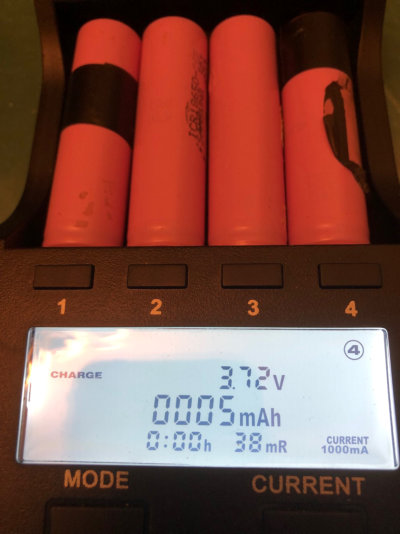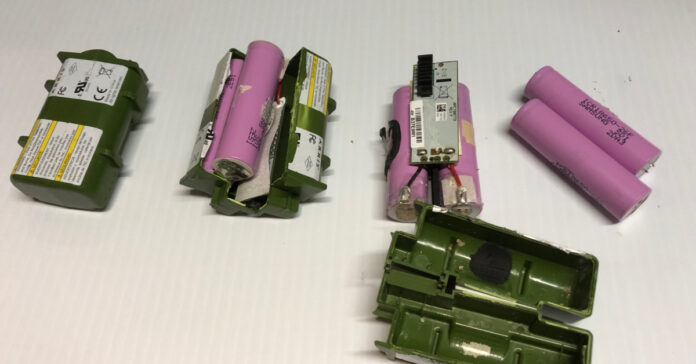If you are a frequent reader, you know that I like the 18650 rechargeable lithium ion battery. When I buy portable electronics and lights, I go out of my way to buy those that use the 18650 battery.
The 18650 is the most popular Li-ion battery in the portable electronics world and was used to power some of the earlier electric cars. The 18650 cells powering electric scooters, skateboards, laptops, power tools, and probably millions of other rechargeable devices. It has a nominal voltage of 3.7 volts and usually offers between 2,600 and 3,400 milliamp hours (mAh). By combing batteries together serially and in parallel, you can devise battery banks that are 12, 18, 24 and 48 volts and provide kilowatts of power. You just have to use the right quantity of cells to fit your application.
Until now, I had been buying commercial 18650s from well-known brands like Tenergy and prominent flashlight makers. Most of these batteries are made by companies like Samsung, LG, Sony, and Panasonic and given a private label treatment by flashlight makers and other companies. Branded 18650s usually cost around $10, although the higher mAh and high-discharge batteries can cost up to $20 each.
I first came across wholesale sources of 18650s while looking into D-I-Y solar power systems a year ago, but only recently have I tinkered with recovering 18650s from commercial battery pack and renovating them for use in my flashlights, headlamps and other devices. Today’s article is an example of that.
Recovering Modem Batteries
They apparently build cable modems with a back-up battery pack to provide some power in case your electricity goes out. This allows you to keep surfing the web or using Wi-Fi on your laptop or phone even in a blackout. I bought fifteen used modem power packs, for $18, or $1.20 each, from www.jag35.com. Each modem pack contains two Samsung 18650s. Shipping cost almost as much as the batteries, driving my cost per battery to just over $1 each.
Once the modem packs arrived, I set about breaking open the battery packs and reclaiming the cells. This was easy, as you can see in the video below.
I used a wood chisel to bust open the housing. It worked better than the cutter used in the video. Also, note that the modem batteries I used were not new but used.
Testing and Charging the Cells
I opened the batteries and tested them using g the DC Volt setting on my electrical tester. Here are the results:
- 11 batteries had sufficient power to be charged on my four-bay LiitoKala (LK) charger/tester.
- 10 batteries had low voltage and could not be charged on the LK. However, I could manually charge some of these batteries until they had sufficient charge to work in the LK.
- 7 batteries showed no voltage and could not be charged using any device. I tried to manually charge them by connecting them to a fully charged battery, which often works on under-charged batteries. No luck. These cells were dead.
- 2 batteries had corrosion or other damage and were useless.
The net result is that I salvaged 21 batteries, just over two thirds, giving me a per-battery cost of about $1.67. That’s a real bargain compared to buying fancy commercial cells. It is also less than buying new cells in large wholesale lots.
The LiitoKala Charger/Tester
The LiitoKala charger charges Li-ion batteries as well as Ni-MH and the older Ni-Cads. It will work on 18650s, 26650s, RCR123s, AAAs and AAs, among others. This makes it very flexible if you have multiple types of rechargeable batteries, but the downside is when you put a battery in it that has only 0.7 volts, it assumes it is a Ni-MH battery and charges it to about 1.8 volts and stops. This would be fine for a Ni-MH C cell or AA, but is not a sufficient charge for an 18650 or other lithium cell. I had to use a dedicated 18650 chargers to help charge the under-charged batteries. A few of cells needed to be boosted by connecting them to fully charged batteries via two wires, positive to positive, negative to negative before they could be charged. This manual approach will often raise the voltage on an otherwise “dead” cell.
The value of the LK is that it can also discharge your cells and test their capacity. I did this on every cell and ended up with cells that were between 2221 and 2638 mAh, with the majority (15 of the 21 cells) above 2400 mAh. I would say that eight of the cells were as good as new.
Surprisingly, some of the highest performing cells, including both that were over 2,600 mAh were from the batch that was discharged so low that they needed manual charging.

Was it Worth it?
Yes. I am delighted to have spent only about $35 to end up with 21 working batteries that would have cost me about $200 if I purchased them one or two at a time. I doubled my store of individual 18650s at a bargain basement price. This will allow me to run my devices twice as long in a lengthy power outage. That means weeks of run time. In terms of meeting my needs as a prepper, this approach worked well.
Opening the modem battery packs and separating the components goes quickly after you have done the first couple and get the hang of it. I’d say I completed this task within an hour. The slowest part of the battery recovery process is I can charge and test only four batteries at a time. That can take up to 12 hours. I got into the habit of filling the charger every morning and emptying it every night, but it took the better part of a week to go from start to finish.
Would I Do it Again?
Yes, I would do this again if I needed another 20 batteries. I am now confident that I could do basic battery builds or rebuilds, like replacing a bad cell in my Ryobi battery packs. I also now now to look disassemble rechargeable tools and equipment after a TEOTWAWKI event to find usable 18650 batteries.
Would I want to disassemble 200 modems to harvest 400 batteries and make a large battery? No, not unless I have a couple weeks of free time on my hands and a dozen chargers. That said, I don’t think the modem batteries are ideal for a D-I-Y battery build because there was so much variation in mAh. If I were to do this, I would consider buying new batteries wholesale or recovering them from another source, such as scooter batteries that have 20 or 40 individual cell in them.
Also, if I were to build my own power wall or large batteries for a solar project, I would want to use the lithium iron phosphate 26650 batteries, which can take more charge/discharge cycles instead of the 18650s. For now, however, I am happy with my new 18650s. I’ve already put two into use, given two to a buddy, and put the rest into storage.
Rating

These battery packs would have rated higher if there were fewer dead cells and more consistent performance across the cells. But for used, recovered cells that probably sat in someone’s cable modem for months or years, this isn’t bad at all. I would buy them again, the service was good, and shipping was faster than I expected.
Please note: The only relationship I have with the website mentioned in this article is as a customer. I bought the modem battery packs with my own funds and the company had no idea I was going to review them. I have had the LiitoKala for approximately eight months. The links in this article are not commission links. The model battery packs are sold as is and you may have better or worse results.








